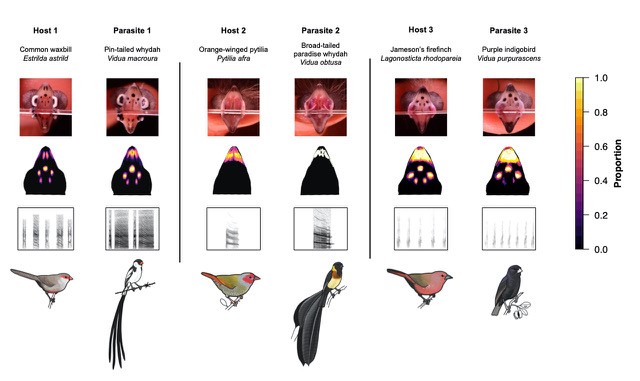Parasitic finches mimic their hosts to deceive foster parents


Research recently published in the journal Evolution shows that the nestlings of brood-parasitic finches mimic the appearance, sound and movements of their host’s chicks. Working in the savannas of Zambia, Dr Gabriel Jamie a research associate at the FitzPatrick Institute of African Ornithology at UCT, and a team of international collaborators collected images, sounds and videos over four years to demonstrate this striking and highly specialised form of mimicry.
The study, funded by The Leverhulme Trust, focussed on a remarkable group of finches that occurs across much of Africa called the indigobirds and whydahs (genus Vidua). This is a group of 19 species, which, like many cuckoos, forego their parental duties and instead lay their eggs in the nests of other birds (“hosts”). The hosts then incubate the foreign eggs and feed the young. These hosts are unusual in having brightly coloured and distinctively patterned nestlings. Furthermore, the nestlings of each host species have their own unique appearance, begging calls and begging movements.
“Vidua finches are extremely specialised parasites with each species mostly exploiting a single host species. While previous work had suggested such visual mimicry may exist, this had never been quantitatively tested from a bird’s visual perspective. Birds process colour and pattern differently to how humans do, so it is important to use models that approximate their visual systems” says Dr Jamie, a research scientist at the University of Cambridge and research associate at the FitzPatrick Institute of African Ornithology, University of Cape Town. “The current paper therefore answers a long-standing question as to whether these parasitic finches really do mimic their respective host’s nestlings.”

The diversity of nestling grassfinch (host) species. First and second row: photographs of the mouth markings of nestling grassfinch species, many of which are hosts to Vidua finches. Top row, left to right: locust finch, common waxbill, blue waxbill, green-winged pytilia, orange-winged pytilia. Second row, left to right: red-billed firefinch, Jameson’s firefinch, zebra waxbill, African quailfinch, bronze mannikin. Bottom row, left to right, green-winged pytilia, red-billed firefinch and locust finch.
All photos by Gabriel A. Jamie (except green-winged pytilia, in bottom left, by Claire N. Spottiswoode).
While the mimicry is astounding in its accuracy, the authors found minor but striking imperfections. These imperfections may exist because 1) there has been insufficient time for more precise mimicry to evolve, 2) the current levels of mimicry are already good enough to fool the host parents, or 3) the imperfections are actually enhanced versions of the hosts signal that force them to feed the parasite chick even more than it would its own.
The mimicry is not only amazing in its own right but may also have important implications for how new species of parasitic finches evolve. Previous work has shown that speciation in Vidua finches is intimately connected to host switching, owing to a remarkable quirk of their natural history: young Vidua finches imprint on their host species, such that males grow up to imitate the song of their host and females grow up to be attracted to males who sing like the host she was raised by. Females also prefer to lay their eggs in the nest of the same host species as she was born in. Therefore, if a female accidentally lays her egg in the nest of a new host species, she has the potential to initiate a new lineage of Vidua that now specialises on the new host and is separated from Vidua lineages specialising on traditional hosts. Recent work has suggested that this process may not be sufficient to prevent the collapse of potential new Vidua species through hybridisation. Instead, the mimetic adaptations to different hosts identified in this study may also be critical in the formation of new species.

Mimicry in mouth colour, pattern and begging calls by nestling parasitic finches of their grassfinch hosts. The top row shows photographs of the inside of the mouth of individual nestling estrildids and their Vidua parasites, demonstrating colour and pattern mimicry. The second row shows heat maps of the patterns of black markings on the upper palate of estrildids and their Vidua parasites. These are composite images across multiple individuals. The brighter the colour the greater the proportion of individuals possessing a black marking at that point on the upper palate. The third row shows sonograms of the begging calls of nestling estrildids and their Vidua parasites. Frequency is on the y-axis ranging from 0-20kHz, and time is on the x-axis. Each sonogram section has a duration of one second. The bottom row shows adult males of each species (photographs by Gabriel Jamie, drawings by Faansie Peacock, Faansie’s Bird Book).
“This specialised mimicry is a vivid reflection of the role of learning in genetic evolution” says co-author of the paper from the FitzPatrick Institute at the University of Cape Town, Professor Claire Spottiswoode. The role of behavioural flexibility in influencing the course of genetic evolution is increasingly recognised among biologists. Vidua nestlings imprint on their hosts, altering their mating and host preferences based on early life experiences. These preferences strongly influence the host environment which their offspring grow up in, and therefore the evolutionary selection pressures they experience from foster parents. When maintained over multiple generations, these selection pressures are what generate the astounding host-specific mimetic adaptations that this paper reveals.

A newly-hatched red-billed firefinch begs for food. Red-billed firefinches are the host species to village indigobird. Village indigobird nestlings mimic the appearance of their host’s nestlings.
